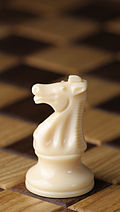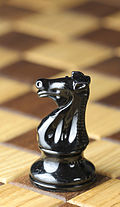
- Chess World Cup
- FIDE Grand Prix
- Olympiad
- World Championship
- List of strong tournaments
- List of world championships

- Checkmate patterns
- Chess openings
- Chess strategy
- Chess tactics
- Chess theory
- Endgames
- Pawn structure
- Problems/Compositions












 White knight
White knight Black knight
Black knight  |
King |
|---|---|
  |
Queen |
  |
Rook |
  |
Bishop |
  |
Knight |
  |
Pawn |
The knight (♘ ♞) is a piece in the game of chess, representing a knight (armored cavalry). It is normally represented by a horse's head and neck. Each player starts with two knights, which begin on the row closest to the player, one square from each corner.
The knight move is unusual among chess pieces. When it moves, it can move to a square that is two squares horizontally and one square vertically, or two squares vertically and one square horizontally. The complete move therefore looks like the letter L. Unlike all other standard chess pieces, the knight can 'jump over' all other pieces (of either color) to its destination square. It captures an enemy piece by replacing it on its square. The knight's ability to "jump over" other pieces means it tends to be at its most powerful in closed positions, in contrast to that of a bishop. The move is one of the longest-surviving moves in chess, having remained unchanged since before the seventh century. Because of this it also appears in most chess-related regional games. The knight moves alternately to light and dark squares.
A knight should always be close to where the action is, meaning it is best used on areas of the board where the opponent's pieces are clustered or close together. Pieces are generally more powerful if placed near the center of the board, but this is particularly true for a knight. A knight on the edge of the board attacks only three or four squares (depending on its exact location) and a knight in the corner only two. Moreover, it takes more moves for an uncentralized knight to switch operation to the opposite side of the board than an uncentralized bishop, rook, or queen. The mnemonic phrases "A knight on the rim is grim" or "A knight on the rim is dim" are often used in chess instruction to reflect this principle.
| a | b | c | d | e | f | g | h | ||
| 8 |

    |
8 | |||||||
| 7 | 7 | ||||||||
| 6 | 6 | ||||||||
| 5 | 5 | ||||||||
| 4 | 4 | ||||||||
| 3 | 3 | ||||||||
| 2 | 2 | ||||||||
| 1 | 1 | ||||||||
| a | b | c | d | e | f | g | h | ||
| a | b | c | d | e | f | g | h | ||
| 8 |

            |
8 | |||||||
| 7 | 7 | ||||||||
| 6 | 6 | ||||||||
| 5 | 5 | ||||||||
| 4 | 4 | ||||||||
| 3 | 3 | ||||||||
| 2 | 2 | ||||||||
| 1 | 1 | ||||||||
| a | b | c | d | e | f | g | h | ||
| a | b | c | d | e | f | g | h | ||
| 8 |

   |
8 | |||||||
| 7 | 7 | ||||||||
| 6 | 6 | ||||||||
| 5 | 5 | ||||||||
| 4 | 4 | ||||||||
| 3 | 3 | ||||||||
| 2 | 2 | ||||||||
| 1 | 1 | ||||||||
| a | b | c | d | e | f | g | h | ||
The knight is the only piece that can move at the beginning of the game without first moving a pawn. For the reasons above, the best square for the initial move of each knight is usually one towards the center. Knights are usually brought into play slightly sooner than the bishops and much sooner than the rooks and the queen.
Because of its move pattern, the knight is especially well-suited for executing a fork.
| a | b | c | d | e | f | g | h | ||
| 8 |

                                                                |
8 | |||||||
| 7 | 7 | ||||||||
| 6 | 6 | ||||||||
| 5 | 5 | ||||||||
| 4 | 4 | ||||||||
| 3 | 3 | ||||||||
| 2 | 2 | ||||||||
| 1 | 1 | ||||||||
| a | b | c | d | e | f | g | h | ||
In the numbered diagram, the numbers represent how many moves it takes for a knight to reach each square on the chessboard from its location on the f5-square.
A knight is approximately equal in strength and value to a bishop. The bishop has longer range, but is restricted to only half the squares on the board. Since the knight can jump over pieces which obstruct other pieces, it is usually more valuable when the board is more crowded (closed positions). A knight is best when it has a 'support point' or outpost - a relatively sheltered square where it can be positioned to exert its strength remotely. On the fourth rank a knight is comparable in power to a bishop, and on the fifth it is often superior to the bishop, and on the sixth rank it can be a decisive advantage. This is assuming the knight is taking part in the action; a knight on the sixth rank which is not doing anything useful is not a well-placed piece.
| a | b | c | d | e | f | g | h | ||
| 8 |

                       |
8 | |||||||
| 7 | 7 | ||||||||
| 6 | 6 | ||||||||
| 5 | 5 | ||||||||
| 4 | 4 | ||||||||
| 3 | 3 | ||||||||
| 2 | 2 | ||||||||
| 1 | 1 | ||||||||
| a | b | c | d | e | f | g | h | ||
Enemy pawns are very effective at harassing knights because a pawn attacking a knight is not itself attacked by the knight. For this reason, a knight is most effective when placed in a weakness in the opponent's pawn structure, i.e. a square which cannot be attacked by enemy pawns. In the diagram at right, White's knight on d5 is very powerful - more powerful than Black's bishop on g7.
Whereas two bishops cover each other's weaknesses, two knights tend not to cooperate with each other as efficiently. As such, a pair of bishops is usually considered better than a pair of knights (Flear 2007:135). World Champion José Raúl Capablanca considered that a queen and a knight is usually a better combination than a queen and a bishop. However, Glenn Flear found no game of Capablanca's that supported his statement and statistics do not support the statement either (Flear 2007:135). In an endgame without other pieces or pawns, two knights generally have a better chance against a queen than two bishops or a bishop and a knight would (see fortress (chess)).
From Mednis| a | b | c | d | e | f | g | h | ||
| 8 |

    |
8 | |||||||
| 7 | 7 | ||||||||
| 6 | 6 | ||||||||
| 5 | 5 | ||||||||
| 4 | 4 | ||||||||
| 3 | 3 | ||||||||
| 2 | 2 | ||||||||
| 1 | 1 | ||||||||
| a | b | c | d | e | f | g | h | ||
Compared to a bishop, a knight is often not as good in an endgame. The knight's potential range of movement is more limited, which often makes it less suitable in endgames with pawns on both sides of the board. However, this limitation is less important in endgames with pawns on only one side of the board. Knights are superior to bishops in an endgame if all the pawns are on one side of the board. Furthermore, knights have the advantage of being able to control squares of either color, unlike a lone bishop. Nonetheless, a disadvantage of the knight (compared to the other pieces) is that by itself it cannot lose a move to put the opponent in zugzwang (see triangulation and tempo), while a bishop can. In this position, if the knight is on a white square and it is White's turn to move, White cannot win. Similarly, if the knight was on a black square and it was Black's turn to move, White cannot win. In the other two cases, White would win. If instead of the knight, White had a bishop on either color of square, White would win with either side to move (Mednis 1993:7-8).
| a | b | c | d | e | f | g | h | ||
| 8 |

    |
8 | |||||||
| 7 | 7 | ||||||||
| 6 | 6 | ||||||||
| 5 | 5 | ||||||||
| 4 | 4 | ||||||||
| 3 | 3 | ||||||||
| 2 | 2 | ||||||||
| 1 | 1 | ||||||||
| a | b | c | d | e | f | g | h | ||
At the end of the game, if one side has only a king and a knight while the other side has only a king, the game is a draw since a checkmate is impossible. When a bare king faces a king and two knights, checkmate can occur only if the opponent commits a blunder by moving his king to a square where it may be checkmated on the next move. Otherwise, a checkmate can never be forced. However checkmate can be forced with a bishop and knight, or with two bishops, even though the bishop and knight are in general about equal in value. Paradoxically, checkmate with two knights sometimes can be forced if the weaker side has a single extra pawn, but this is a curiosity of little practical value (see two knights endgame). Pawnless endings are a rarity, and if the stronger side has even a single pawn, an extra knight should give him an easy win. A bishop can trap (although it cannot then capture) a knight on the rim (diagram), especially in the endgame.
In algebraic notation, the usual modern way of recording chess games, the letter N stands for the knight (K is reserved for the king); in descriptive chess notation, Kt is sometimes used instead, mainly in older literature. In chess problems and endgame studies, the letter S, standing for the German name for the piece, Springer, is often used (and in some variants of fairy chess N is used for the popular fairy chess piece, the nightrider).
Read main article: Chess symbols in Unicode
Unicode defines two codepoints for knight:
♘ U+2658 White Chess Knight (HTML ♘)
♞ U+265E Black Chess Knight (HTML ♞)